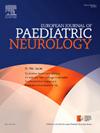Somatosensory profile in individuals with duchenne muscular dystrophy: A quantitative sensory testing (QST) study
IF 2.3
3区 医学
Q3 CLINICAL NEUROLOGY
引用次数: 0
Abstract
Objective
This study aimed to quantify somatosensory profiles in individuals with Duchenne muscular dystrophy (DMD).
Methods
We included 28 participants with genetically confirmed DMD (aged 8–17 years), 14 with chronic pain (DMD-CP), and 14 without pain (DMD-NP), compared to 13 healthy controls (HC) matched for age and sex. Three quantitative sensory testing (QST) modalities were examined: pressure pain threshold (PPT), temporal summation of pain (TSP) and conditioned pain modulation (CPM). Characteristics related to chronic pain, fatigue, psychological distress, and health-related quality of life were assessed using questionnaires.
Results
Decreased PPTs were found in both DMD cohorts across body areas commonly affected by pain (rectus femoris, medial gastrocnemius, paraspinal muscles, upper trapezius), as well as in a less frequently affected remote area (thenar eminence), compared to HCs (p < 0.001). The DMD-CP group exhibited greater TSP compared to HCs (p = 0.025). There were no differences in CPM effects between DMD groups and HCs. No differences were detected in all QST measures between DMD-CP and DMD-NP.
Significance
This study is the first to explore the somatosensory profile in DMD. Preliminary evidence suggests that generalized hyperalgesia may be a common feature in DMD regardless of pain status. QST measures appear to not distinguish individuals with chronic pain from those without and thus are not recommended for assessing pain in DMD or guiding treatment.
杜兴氏肌肉萎缩症患者的体感特征:定量感觉测试 (QST) 研究
本研究旨在量化杜氏肌营养不良症(DMD)患者的体感特征。方法我们纳入了 28 名经基因证实的 DMD 患者(8-17 岁),其中 14 人患有慢性疼痛(DMD-CP),14 人无疼痛(DMD-NP),并与 13 名年龄和性别匹配的健康对照组(HC)进行了比较。研究人员对三种定量感觉测试 (QST) 模式进行了检测:压力痛阈 (PPT)、疼痛的时间累加 (TSP) 和条件性疼痛调节 (CPM)。结果发现,与 HCs 相比,DMD 两组受疼痛影响的常见身体部位(股直肌、腓肠肌内侧、脊柱旁肌肉、斜方肌上部)以及受影响较少的远端部位(耳后圆突)的 PPT 均有所下降(p < 0.001)。与普通人相比,DMD-CP 组的 TSP 更大(p = 0.025)。DMD 组和 HC 组的 CPM 效果没有差异。在所有 QST 测量中,DMD-CP 和 DMD-NP 之间均未发现差异。初步证据表明,无论疼痛状况如何,全身痛觉减退可能是 DMD 的共同特征。QST 测量似乎无法区分慢性疼痛患者和非慢性疼痛患者,因此不建议用于评估 DMD 患者的疼痛或指导治疗。
本文章由计算机程序翻译,如有差异,请以英文原文为准。
求助全文
约1分钟内获得全文
求助全文
来源期刊
CiteScore
6.30
自引率
3.20%
发文量
115
审稿时长
81 days
期刊介绍:
The European Journal of Paediatric Neurology is the Official Journal of the European Paediatric Neurology Society, successor to the long-established European Federation of Child Neurology Societies.
Under the guidance of a prestigious International editorial board, this multi-disciplinary journal publishes exciting clinical and experimental research in this rapidly expanding field. High quality papers written by leading experts encompass all the major diseases including epilepsy, movement disorders, neuromuscular disorders, neurodegenerative disorders and intellectual disability.
Other exciting highlights include articles on brain imaging and neonatal neurology, and the publication of regularly updated tables relating to the main groups of disorders.

 求助内容:
求助内容: 应助结果提醒方式:
应助结果提醒方式:


